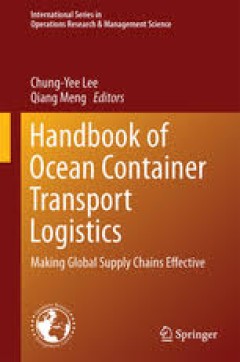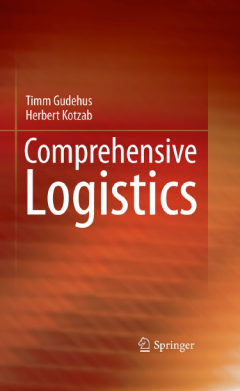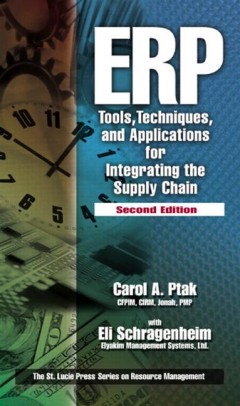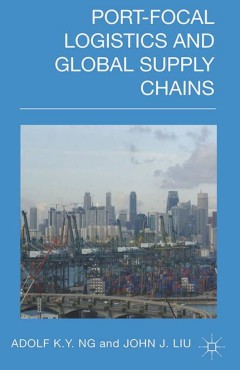Ditapis dengan

The terminalization of supply chains: reassessing the role of terminals in po…
The paper discusses how logistics service providers are using terminals in their supply chains. It argues that an increasing ‘terminalization’ of supply chains is unfolding, whereby seaport and inland terminals are taking up a more active role in supply chains by increasingly confronting market players with operational considerations such as imposing berthing windows, dwell time charges, tr…
- Edisi
- VOL. 36, NO. 2, 165–183
- ISBN/ISSN
- 1464–5254
- Deskripsi Fisik
- 21 p.
- Judul Seri
- Maritime Policy & Management: The flagship journal of international shipping and port research
- No. Panggil
- ATC LO ROD t

Sustainability assessment of food chain logistics
Food chain logistics plays an important role in the sustainability performance of the food sector. Therefore, project SCALE (Step Change in Agri-food Logistics Ecosystems) started as a collaborative international project, aiming for tools and frameworks for the food sector to make a step change in operational practices. A sustainability framework is introduced to propose a structured and ration…
- Edisi
- Vol. 18, No. 2, 101–117
- ISBN/ISSN
- 1469-848X
- Deskripsi Fisik
- 18 p.
- Judul Seri
- International Journal of Logistics Research and Applications
- No. Panggil
- ATC LO BLO s

Information Technology as the Main Competence in the Design of the Strategic …
The creation of logistical support structures aims to help improve the performance of logistics along supply chains, a context where the Logistics Platforms have been gaining increasing prominence. A frequent difficulty in these ventures is to align strategic planning with the flow of cargo and the ability of the adjacent port areas. Aiming to contribute to the understanding of the importance o…
- Edisi
- 2013, Volume 8, Issue 3
- ISBN/ISSN
- 0718-2724
- Deskripsi Fisik
- 13 p.
- Judul Seri
- Journal of Technology Management and Innovation
- No. Panggil
- ATC LO VAR i

Maritime Logistics and Supply Chain Security
Despite a hangover from the worldwide economic crisis, international trade rebounded nicely with a record-level growth in late 2010. A sharp rise in international trade has sparked the international traffic growth. A majority of this traffic growth originated from maritime logistics which could move cargoes in large volume and at cheaper freight costs. Due to its cost-efficiency and easy acces…
- Edisi
- 2012
- ISBN/ISSN
- 978-1-78052-340-8
- Deskripsi Fisik
- 27 P
- Judul Seri
- Maritime Logistics
- No. Panggil
- ATC LO MIN m

Handbook of ocean container transport logistics: making global supply chains …
- Edisi
- -
- ISBN/ISSN
- 2214-7934
- Deskripsi Fisik
- xvii, 552 p.
- Judul Seri
- -
- No. Panggil
- TXT LO LEE h
- Edisi
- -
- ISBN/ISSN
- 2214-7934
- Deskripsi Fisik
- xvii, 552 p.
- Judul Seri
- -
- No. Panggil
- TXT LO LEE h

Comprehensive logistics
- Edisi
- -
- ISBN/ISSN
- 978-3-540-68652-1
- Deskripsi Fisik
- -
- Judul Seri
- -
- No. Panggil
- TXT LO KOT c
- Edisi
- -
- ISBN/ISSN
- 978-3-540-68652-1
- Deskripsi Fisik
- -
- Judul Seri
- -
- No. Panggil
- TXT LO KOT c
Advances in Maritime Logistics and Supply Chain Systems
Over the recent years, maritime logistics and supply chains have witnessed tremendous growth rates around the world, notwithstanding the recent economic downturn. Maritime transportation accounts for the majority of international trade and it has become a vital factor for the economic health of many nations. In emrging economies, more new ports have also been developed to tap into the global ma…
- Edisi
- -
- ISBN/ISSN
- 978-981-4329-85-9
- Deskripsi Fisik
- xiii, 213p
- Judul Seri
- -
- No. Panggil
- TXT LO CHE a

ERP tools, techniques, and applications for Integrating the supply chain
Enterprise Resource Planning (ERP) has been successful in many companies and yet many others have struggled with their efforts. If companies would read this book before beginning their journey toward ERP there would be more success stories. This book is very comprehensive in its coverage of ERP and related topics. There is a chapter on the Theory of Constraints (TOC) and it is the first ERP boo…
- Edisi
- 2nd
- ISBN/ISSN
- 1-57444-358-5
- Deskripsi Fisik
- 414
- Judul Seri
- -
- No. Panggil
- TXT LO PTA e

Port-Focal Logistics and Global Supply Chains
This book explores the intersection of two trends in the port sector that have occupied researchers in recent years: the port's progressively interventionist role in the hinterland and its increasing importance as a node within supply chains. These trends are set against the backdrop of fierce port competition as the increasing size of modern container vessels drives ports to make huge investm…
- Edisi
- -
- ISBN/ISSN
- 978-1-349-44539-4
- Deskripsi Fisik
- -
- Judul Seri
- -
- No. Panggil
- TXT PO ADO p
Port-Focal Logistics and Global Supply Chains
- Edisi
- -
- ISBN/ISSN
- 978–1–137–27368–0
- Deskripsi Fisik
- xx, 244 p
- Judul Seri
- -
- No. Panggil
- TXT PO ADO p
- Edisi
- -
- ISBN/ISSN
- 978–1–137–27368–0
- Deskripsi Fisik
- xx, 244 p
- Judul Seri
- -
- No. Panggil
- TXT PO ADO p

Industrial dynamics modelling of supply chains
The use of industrial dynamics modelling of real-life supply chains has only recently re-emerged from the shadows after a lengthy gestation period. Shows that it is a powerful methodology for predicting and prioritizing methods of re-engineering the chain in order to achieve enhanced performance when viewed from the perspective of all “players” in the chain. Building an adequate model of an…
- Edisi
- Volume 9 · Number 4 · 1996 · 43–56
- ISBN/ISSN
- -
- Deskripsi Fisik
- 17 p.
- Judul Seri
- Logistics Information Management
- No. Panggil
- ATC LO TOW i

Logistics service quality and its effects on customer satisfaction in the man…
The purpose of this paper is to implement a multi-criteria preference disaggregation approach to measure logistics service quality (LSQ) of manufacturing companies’ supply chains.
- Edisi
- Vol. 9 No. 2, 2014
- ISBN/ISSN
- -
- Deskripsi Fisik
- 25 p.
- Judul Seri
- Journal of Modelling in Management
- No. Panggil
- ATC LO BIN l

Containerisation, box logistics and global supply chains: the integration of …
In 2006, container shipping celebrated its 50th anniversary as an innovation that had a tremendous impact on the geography of production and distribution. Production became globalised by a better usage of comparative advantages while distribution systems were able to interact more efficiently. This paper analyses the mounting pressures on box logistics in light of global supply chains. It will …
- Edisi
- -
- ISBN/ISSN
- -
- Deskripsi Fisik
- 23 p.
- Judul Seri
- Maritime Economics & Logistics
- No. Panggil
- ATC LO PAUL c

An analysis of keywords used in the literature on green supply chain management
The purpose of this paper is to analyze the keywords used in peer-reviewed literature on green supply chain management.
- Edisi
- Vol. 38 Iss 2 pp. 166 - 194
- ISBN/ISSN
- 2040-8269
- Deskripsi Fisik
- 31 p.
- Judul Seri
- Management Research Review
- No. Panggil
- ATC LO GUR a

A Comparison of FMCG Logistics Operations In The UK And South Africa
Purpose – International comparison studies provide a useful opportunity in logistics to benchmark logistics practices. Given this, it is perhaps surprising that there do not appear to be any benchmarking studies comparing performance between the developed and developing world. The paper aims to address this shortcoming, focusing on fast moving consumer goods (FMCG) distribution networks from …
- Edisi
- Vol. 25 Iss 4 pp
- ISBN/ISSN
- 0955-534X
- Deskripsi Fisik
- 15 p
- Judul Seri
- European Business Review
- No. Panggil
- ATC LO ROD a

Humanitarian supply chains and performance measurement schemes in practice
The purpose of this paper is to provide a system for the performance evaluation of humanitarian supply chains. The system will help humanitarian organizations (HOs) to make better decisions, improve their performance, and provide accountability, as well as helping them measure their operational performance during disaster response and reconstruction projects.
- Edisi
- Vol. 64 No. 6, 2015
- ISBN/ISSN
- -
- Deskripsi Fisik
- 30 p.
- Judul Seri
- International Journal of Productivity and Performance Management
- No. Panggil
- ATC LO SAN h

Stakeholder forces of socially responsible supply chain management orientation
This project investigates salient stakeholder forces of socially responsible supply chain orientation (SRSCO) in the apparel and footwear sector focusing on fair labor management issues. SRSCO was conceptualized as a composite of internal organizational direction and external partnership for a creation and continuation of fair labor conditions throughout the supply chain. Primary stakeholders i…
- Edisi
- -
- ISBN/ISSN
- -
- Deskripsi Fisik
- 18 p.
- Judul Seri
- -
- No. Panggil
- ATC LO REE s

A fuzzy AHP and TOPSIS methodology to evaluate 3PL in a supply chain
The purpose of this paper is to provide an insight into the use of an integrated approach of fuzzy analytical hierarchy process (fuzzy AHP) and TOPSIS in evaluating the performance of global third party logistics service providers for effective supply chain management.
- Edisi
- Vol. 7 No. 3, 2012 pp. 287-303
- ISBN/ISSN
- 1746-5664
- Deskripsi Fisik
- 19 p.
- Judul Seri
- Journal of Modelling in Management
- No. Panggil
- ATC LO KUM a

Performance-Based Logistics: A Portfolio For Contracting Military Supply
Purpose – The purpose of this research is to analyse military logistics providing a decision support instrument for contracting in defence supply chains. Design/methodology/approach – This instrument – the Performance-Based Logistics (PBL) portfolio – is developed following the contingency approach. Qualitative interviews and illustrative examples from Germany, Austria and Switzerla…
- Edisi
- Vol. 43 Iss 2
- ISBN/ISSN
- 0960-0035
- Deskripsi Fisik
- 21 p
- Judul Seri
- International Journal of Physical Distribution & Logistics Management
- No. Panggil
- ATC LO GLA p

Globalization, public sector reform, and the role of ports in international s…
- Edisi
- -
- ISBN/ISSN
- -
- Deskripsi Fisik
- 51 p.
- Judul Seri
- -
- No. Panggil
- ATC PO HAR c
- Edisi
- -
- ISBN/ISSN
- -
- Deskripsi Fisik
- 51 p.
- Judul Seri
- -
- No. Panggil
- ATC PO HAR c

An integrated terminal operating system for enhancing the efficiency of seapo…
A seaport terminal is a vital link in the global supply chain which has a profound impact on port competitiveness and international trade. However, ongoing worldwide economic slumps, coupled with the proliferation of terminal operators, have created a glut for terminal-related logistics services and intensified competition among terminal operators. As a way to better utilize the existing termin…
- Edisi
- -
- ISBN/ISSN
- -
- Deskripsi Fisik
- 23 P.
- Judul Seri
- -
- No. Panggil
- ATC LO MIN a

Sensible operational choices for the climate change agenda
The increasing focus on environmental sustainability and social responsibility within business agendas often leads to expectations that solutions lie in the downscaling, decentralising and deconsolidating of supply chains and logistics systems. This is no more acute than within the climate change agenda, the single biggest environmental challenge to industry today. The purpose of this paper is …
- Edisi
- Vol. 21 No. 3, 2010 pp. 538-557
- ISBN/ISSN
- -
- Deskripsi Fisik
- 22 p.
- Judul Seri
- The International Journal of Logistics Management
- No. Panggil
- ATC LO OLG s

Retail operational strategies in complex supply chains
The correct choice, implementation and evolution of an operations strategy can provide considerable competitive advantage. However, how many organizations in the Fast Moving Consumer Goods (FMCG) industries really understand the components of such strategies and their power when properly deployed? Supply chain management, lean thinking, agile operations, quick response, virtual organization, ti…
- Edisi
- Vol. 12 Issue: 1, pp.97-111
- ISBN/ISSN
- -
- Deskripsi Fisik
- 17 p.
- Judul Seri
- The International Journal of Logistics Management
- No. Panggil
- ATC LO LOW r

Moderating effect of environmental supply chain collaboration: Evidence from …
The purpose of this paper is to explore how corporate environmental strategies, namely, environmental management strategy (EMS) and green product strategy (GPS), affect the competitiveness of a firm. In addition, this study investigates whether the environmental collaboration in supply chains (ECSC), namely, environmental collaboration with suppliers (ECS), and environmental collaboration with …
- Edisi
- Tienhua Wu
- ISBN/ISSN
- -
- Deskripsi Fisik
- 22 p.
- Judul Seri
- International Journal of Physical Distribution & Logistics Management
- No. Panggil
- ATC LO CHE m

Introducing the concept of information supply chains: the Buddy project
The European Community ESPRIT Project Buddy addresses the needs of industrial organisations to reduce information processing time, improve added and residual value of information, and reduce processing and distribution costs and “leadtimes”. It deals with the information supply‐chain as an important entity, whose performance and optimisation very significantly affect the efficiency and pe…
- Edisi
- Vol. 11 Issue: 2, pp.74-79
- ISBN/ISSN
- -
- Deskripsi Fisik
- 8 p.
- Judul Seri
- Logistics Information Management
- No. Panggil
- ATC LO KOU i

Climate policy and solutions for green supply chains: Europe’s predicament
This paper aims to measure carbon footprints (CFs) of products at the sectoral levels. The paper also aims to provide potential solutions to adopt greener supply chains to minimise CFs.
- Edisi
- Volume 20 · Number 3 · 2015 · 249–263
- ISBN/ISSN
- -
- Deskripsi Fisik
- 16 p .
- Judul Seri
- Supply Chain Management: An International Journal
- No. Panggil
- ATC LO BON c

How “smart cities” will change supply chain management
The purpose of this paper is to analyze the impact of smart city initiatives and big data on supply chain management (SCM). More specifically, the connections between smart cities, big data and supply network characteristics (supply network structure and governance mechanisms) are investigated.
- Edisi
- Volume 20 · Number 3 · 2015 · 237–248
- ISBN/ISSN
- -
- Deskripsi Fisik
- 14 p.
- Judul Seri
- Supply Chain Management: An International Journal
- No. Panggil
- ATC LO MEN h

Reducing transportation greenhouse gas emissions with collaborative distribut…
The purpose of this paper is to study the potential for improving sustainability performance in food supply networks by implementing collaborative distribution. Food supply chains generate a significant portion of CO2 emissions, because of the large volume of food transportation and the large number and frequency of trips made to deliver food products to retail stores, making it available to th…
- Edisi
- Vol. 38 No. 10, 2015 pp. 1049-1067
- ISBN/ISSN
- -
- Deskripsi Fisik
- 21 p .
- Judul Seri
- Management Research Review
- No. Panggil
- ATC LO MEN r

Maritime Logistics and Supply Chain Security
Despite a hangover from the worldwide economic crisis, international trade rebounded nicely with a record-level growth in late 2010. A sharp rise in international trade has sparked the international traffic growth. A majority of this traffic growth originated from maritime logistics which could move cargoes in large volume and at cheaper freight costs. Due to its cost-efficiency and easy access…
- Edisi
- Vol. 34 Iss 10 pp
- ISBN/ISSN
- -
- Deskripsi Fisik
- 27 p.
- Judul Seri
- Maritime Logistics
- No. Panggil
- ATC LO MIN m
 Karya Umum
Karya Umum  Filsafat
Filsafat  Agama
Agama  Ilmu-ilmu Sosial
Ilmu-ilmu Sosial  Bahasa
Bahasa  Ilmu-ilmu Murni
Ilmu-ilmu Murni  Ilmu-ilmu Terapan
Ilmu-ilmu Terapan  Kesenian, Hiburan, dan Olahraga
Kesenian, Hiburan, dan Olahraga  Kesusastraan
Kesusastraan  Geografi dan Sejarah
Geografi dan Sejarah